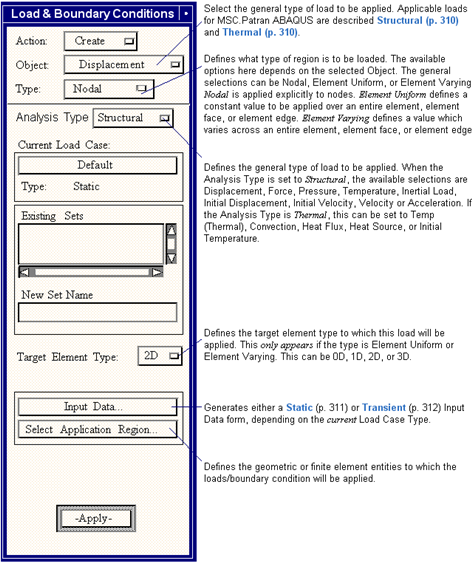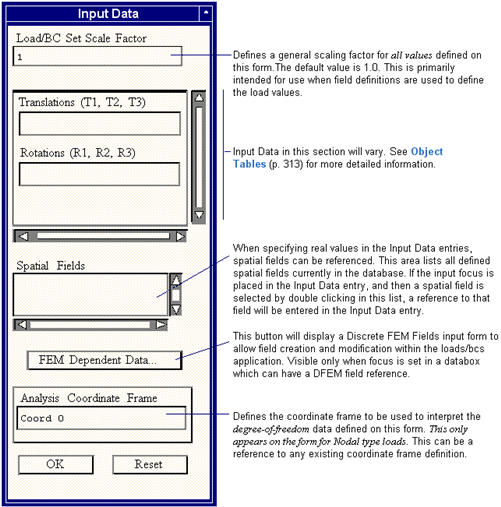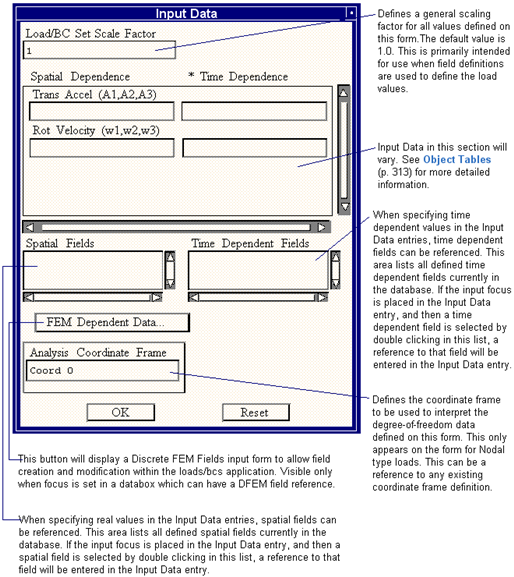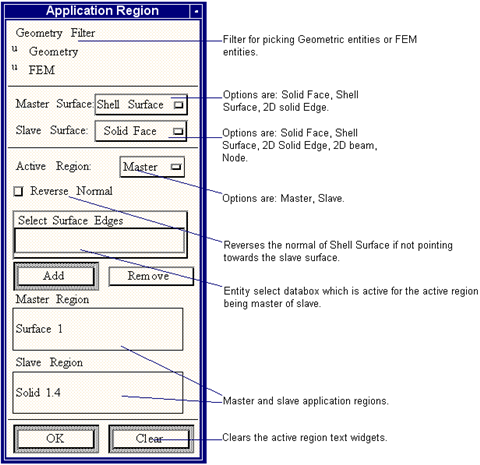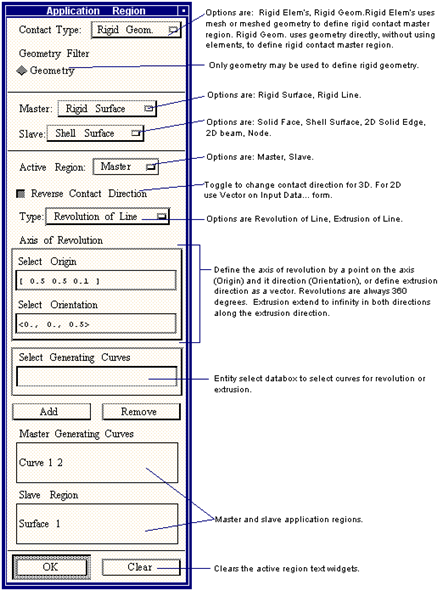XXXXXXXXXXXXXXXXXXXXXXXXXXXXXXXXXXXXXXXXXXXXXXXXXXXXXXXXXXXXXXXXXXXXXXXXXXXXXXXXXXXXXXXXXXXXXXXXXXXXXXXXXXXXXXXXXXXXXXXXXXXXXXXXXXXXXXXXXXXXXXXXXXXXXXXX''"> Loads and Boundary Conditions
When choosing the Loads/BCs toggle, the Loads and Boundary Conditions form will appear. The selections made will determine which loads and boundary form is presented, and ultimately, which ABAQUS loads and boundaries will be created.
The following pages give an introduction to the Loads and Boundary Conditions form, followed by the details of all the loads and boundary conditions supported by the Patran ABAQUS
Application Preference.
Loads & Boundary Conditions Form
The Loads & Boundary Conditions form shown below provides the following options for the purpose of creating ABAQUS loads and boundaries. The full functionality of the form is defined in
Loads and Boundary Conditions Form (p. 21) in the Patran Reference Manual.
The following table shows the allowable selections for all options when the Analysis Type is set to Structural.
Analysis Type | Object | Type |
Structural | | Nodal |
| Nodal |
| Element Uniform |
| Nodal
Element Uniform
Element Variable |
| Element Uniform |
| Nodal |
| Nodal |
| Nodal |
| Element Uniform |
| Element Uniform |
• Pre-Tension | Element Uniform |
The following table shows the allowable selections for all options when the Analysis Code is set to Thermal.
Analysis Type | Object | Type |
Thermal | | Nodal |
| Element Uniform |
| Element Uniform |
| Nodal
Element Uniform |
| Nodal |
Input Data
Clicking on the Input Data button generates either a Static or Transient Input Data form, depending on the current Load Case Type.
Static
This subordinate form appears whenever Load Case Type is set to Static and the Input Data button is clicked. The information contained on this form will vary according to the Object that has been selected. Information that remains standard to this form is defined below.
Transient
This subordinate form appears whenever Load Case Type is set to Transient and the Input Data button is clicked. The information contained on this form will vary according to the Object that has been selected. Information that remains standard to this form is defined below.
Object Tables
On the static and transient input data forms are areas where the load data values are defined. The data fields presented depend on the selected load Object and Type. In some cases, the data fields also depend on the selected Target Element Type. These Object Tables list and define the various input data that pertains strictly to a specific selected object:
Displacement
Object | Type | Type |
Displacement | Nodal | Structural |
Creates *BOUNDARY TYPE=DISPLACEMENT options.
Input Data | Description |
Translations (T1,T2,T3) | Defines the enforced translational displacement values. These are in model length units. |
Rotations (R1,R2,R3) | Defines the enforced rotational displacement values. These are in radians. |
Force
Object | Type | Type |
Force | Nodal | Structural |
Creates *CLOAD options.
Input Data | Description |
Force (F1,F2,F3) | Defines the applied forces in the translation degrees-of-freedom. |
Moment (M1,M2,M3) | Defines the applied moments in the rotational degrees-of-freedom. |
Pressure
Object | Type | Type | Dimension |
Pressure | Element Uniform | Structural | 1D |
Creates *DLOAD options.The ABAQUS preference now has support for the *DLOAD ABAQUS entry to create pressure loads on 1D elements. This will let you to put distributed loads on beam elements.
Input Data | Description |
Top Surf Pressure | Defines pressure loading on 1D planar and axisymmetric shell elements using the DIST LOADS option. |
Object | Type | Type | Dimension |
Pressure | Element Uniform | Structural | 2D |
Creates *DLOAD options.
Input Data | Description |
Top Surf Pressure | Defines the magnitude of the pressure in the direction of the negative normal to the shell. |
Bot Surf Pressure | Defines the magnitude of the pressure in the direction of the positive normal to the shell. |
Edge Pressure | Defines the edge pressure value on axisymmetric, plane strain,and plane stress elements. |
Object | Type | Type | Dimension |
Pressure | Element Uniform | Structural | 3D |
Creates *DLOAD options.
Input Data | Description |
Pressure | Defines the face pressure value on solid elements. |
Temperature
Object | Type | Type |
Temperature | Nodal | Structural |
Creates *TEMPERATURE options.
Input Data | Description |
Temperature | Defines the nodal temperature value. |
Object | Type | Type | Dimension |
Temperature | Element Uniform | Structural | 1D
2D
3D |
Creates *TEMPERATURE options.
Input Data | Description |
Temperature | Defines the temperature on elements. |
Object | Type | Type | Dimension |
Temperature | Element Variable | Structural | 1D
2D
3D |
Creates *TEMPERATURE options.
Input Data | Description |
Centroid Temp (1D) | Defines the temperature at the centroid of the beam. |
Axis-1 Gradient (1D) | Defines the temperature gradient along the axis-1 of the beam section. |
Axis-2 Gradient (1D)S | Defines the temperature gradient along the axis-2 of the beam section. |
Top Surf Temp (2D) | Defines the temperature at the top of the shell element. |
Bot Surf Temp (2D) | Defines the temperature at the bottom of the shell element. |
Temperature (3D) | Defines the temperature in the solid element. |
Inertial Load
Object | Type | Type | Dimension |
Inertial Load | Element Uniform | Structural | 0D
1D
2D
3D |
Creates *DLOAD options with the load type set to GRAV, CENT, or CORIO as appropriate.
Input Data | Description |
Trans Accel (A1,A2,A3) | Defines the magnitude and direction of the gravity vector. This must be assigned to all elements which are to have gravity loads. |
Rot Velocity (w1,w2,w3) | Defines the centrifugal and Coriolis forces to be applied to the elements. |
Rot Accel (a1,a2,a3) | These load terms are not currently supported by Patran ABAQUS. |
Initial Velocity
Object | Type | Type |
Initial Velocity | Nodal | Structural |
Creates *INITIAL CONDITIONS TYPE=VELOCITY options.
Input Data | Description |
Trans Veloc (v1,v2,v3) | Defines the initial velocity values for the translational degrees-of-freedom. |
Rot Veloc (w1,w2,w3) | Defines the initial velocity values for the rotational degrees-of-freedom. |
Velocity
Object | Type | Type |
Velocity | Nodal | Structural |
Creates *Boundary, Type=Velocity options.
Input Data | Description |
Trans Veloc (v1,v2,v3) | Defines the velocity values for the translational degrees-of-freedom. |
Rot Veloc (w1, w2, w3) | Defines the velocity values for the rotational degrees-of-freedom. |
Acceleration
Object | Type | Type |
Acceleration | Nodal | Structural |
Creates *Boundary, Type=Acceleration options.
Input Data | Description |
Trans Accel (A1, A2, A3) | Defines the acceleration values for the translational
degrees-of-freedom. |
Rot Accel (a1, a2, a3) | Defines the acceleration values for the rotational degrees-of-freedom. |
Contact (Deform-Deform)
Object | Type | Type |
Contact | Element Uniform | Structural |
Defines the contact between two deformable structural bodies and creates the following ABAQUS
input cards:
*Surface Definition: Master and Slave surface definitions.
*Contact Pair: Pairing of the Master and Slave Surfaces.
*Tie: Tying of the Master and Slave Surfaces (version 6 and greater).
*Surface Interaction: Contact Interaction properties between Master and Slave.
*Contact Controls: Set the Automatic Tolerances parameter
*Contact Inerference: Set the Shrink parameter
Defines the Master and Slave surface interaction properties.
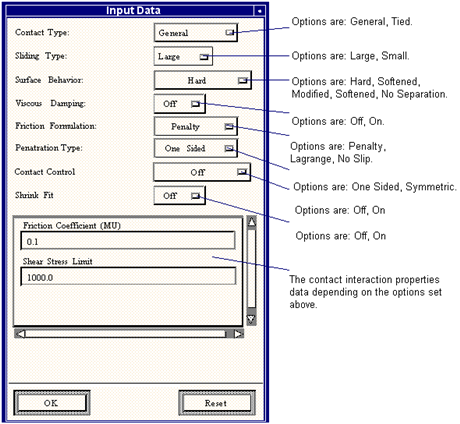
The contact type can be General (contacting surfaces move relative to each other) or Tied (contacting surfaces remain fixed with respect to each other usually used in mesh refinement). The sliding between the contacting surfaces can be Large or Small. For contact in 3D space the sliding is limited to Small sliding. Four types of contact surface behavior options are available, Hard, Softened, Modified Softened, and No Separation. The surfaces do not separate after contact in the case when No Separation option is used. Three types of friction formulations are available, Penalty, Lagrange, and No Slip. In the case of No Slip option there is no relative motion between the contacting surfaces after contact. The Penetration Type can be One Sided (Only the slave nodes are checked against the master surface) or Symmetric (Both the slave and master nodes are checked against each other by swapping the master and slave surfaces). The Contact Control can be turned On to activate the *Contact Control, Automatic Tolerances parameter. Use this parameter to have ABAQUS automatically compute an overclosure tolerance and a separation pressure tolerance to prevent chattering in contact. Shrink Fit can be turned On to activate the *Contact Interference, Shrink parameter. Use this parameter to invoke the automatic shrink fit capability. This capability can be used only in the first step of an analysis. When this parameter is invoked, no data are required other than the contact pairs to which the option is applied.
The application region form is used to pick the master and slave surfaces.
Application Region:
Defines the Master and Slave contacting surfaces.
Contact (Rigid-Deform)
Object | Type | Type |
Contact | Element Uniform | Structural |
Defines the contact between the rigid surface and deformable structural body and creates the following ABAQUS input cards:
*Surface Definition: Master and Slave surface definitions.
*Contact Pair: Pairing of the Master and Slave Surfaces.
*Surface Interaction: Contact Interaction properties between Master and Slave.
*Contact Controls: Set the Automatic Tolerances parameter
*Contact Inerference: Set the Shrink parameter
Defines the Master and Slave surface interaction properties.
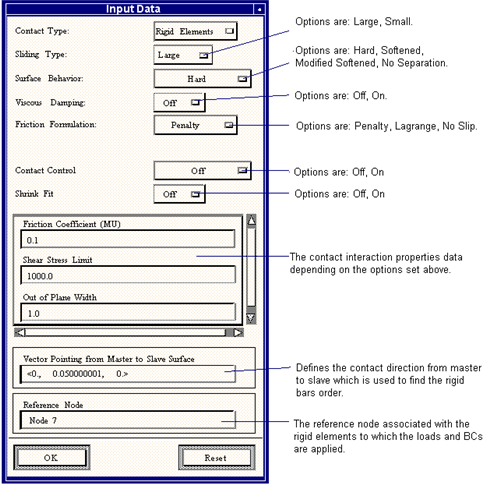
The sliding between the contacting surfaces can be Large or Small. Four types of contact surface behavior options are available, Hard, Softened, Modified Softened, and No Separation. The surfaces do not separate after contact in the case when No Separation option is used. Three types of friction formulations are available, Penalty, Lagrange, and No Slip. In the case of No Slip option there is no relative motion between the contacting surfaces after contact. The Contact Control can be turned On to activate the *Contact Control, Automatic Tolerances parameter. Use this parameter to have ABAQUS automatically compute an overclosure tolerance and a separation pressure tolerance to prevent chattering in contact. Shrink Fit can be turned On to activate the *Contact Interference, Shrink parameter. Use this parameter to invoke the automatic shrink fit capability. This capability can be used only in the first step of an analysis. When this parameter is invoked, no data are required other than the contact pairs to which the option is applied. A vector pointing from the rigid line to the slave surface must be defined. This vector is used to calculate the order of rigid bar elements. The vector should be defined such that the most of the vector markers point away from the rigid line.
The application region form is used to pick the master and slave surfaces.
Application Region:
Defines the Master and Slave contacting surfaces.
Application Region:
Defines the Master and Slave contacting surfaces. This form appears when Contact Type: is Rigid Geom. and Master: is Rigid Surface.
Pre-tension
Object | Type | Option | Type | Dimension |
Pre-tension | Element Uniform | Displacement | Structural | 1D |
Creates *BOUNDARY and *PRE-TENSION SECTION options.
Input Data | Description |
Relative Displacement | Defines the relative displacement to apply to the length of the elements. |
Object | Type | Option | Type | Dimension |
Pre-tension | Element Uniform | Displacement | Structural | 2D, 3D |
Creates *BOUNDARY, *SURFACE and *PRE-TENSION SECTION options.
Input Data | Description |
Relative Displacement | Defines the relative displacement to apply to the underlying elements in the direction of the section's normal. |
Object | Type | Option | Type | Dimension |
Pre-tension | Element Uniform | Force | Structural | 1D |
Creates *CLOAD and *PRE-TENSION SECTION options.
Input Data | Description |
Force | Defines the pre-tension force to apply to the elements. |
Object | Type | Option | Type | Dimension |
Pre-tension | Element Uniform | Force | Structural | 2D, 3D |
Creates *CLOAD, *SURFACE and *PRE-TENSION SECTION options.
Input Data | Description |
Force | Defines the pre-tension force to apply to the underlying elements in the direction of the section's normal. |
Temperature (Thermal)
Object | Type | Type |
Temp (Thermal) | Nodal | Thermal |
Creates *BOUNDARY options.
Input Data | Description |
Temperature | Defines the nodal temperature value. |
Convection
Object | Type | Type | Dimension |
Convection | Element Uniform | Thermal | 2D |
Creates *FILM options.
Input Data | Description |
Top Surf Convection | Defines the convection coefficient for the top surface of a shell element. |
Bot Surf Convection | Defines the convection coefficient for the bottom surface of a shell element. |
Edge Convection | Defines the convection coefficient for the edges of axisymmetric, plane strain, and plane stress type elements. |
Ambient Temp | Defines the ambient temperature. |
Object | Type | Type | Dimension |
Convection | Element Uniform | Thermal | 3D |
Creates *FILM options.
Input Data | Description |
Convection | Defines the convection coefficient for the face of a solid element. |
Ambient Temp | Defines the ambient temperature. |
Heat Flux
Object | Type | Type | Dimension |
Heat Flux | Element Uniform | Thermal | 2D |
Creates *DFLUX options.
Input Data | Description |
Top Surf Heat Flux | Defines the heat flux for the top surface of a shell element. |
Bot Surf Heat Flux | Defines the heat flux for the bottom surface of a shell element. |
Edge Heat Flux | Defines the heat flux for the edges of axisymmetric, plane strain, and plane stress type elements. |
Object | Type | Type | Dimension |
Heat Flux | Element Uniform | Thermal | 3D |
Creates *DFLUX options.
Input Data | Description |
Heat Flux | Defines the heat flux for the face of a solid element. |
Heat Source
Object | Type | Type |
Heat Source | Nodal | Thermal |
Creates *CFLUX options.
Input Data | Description |
Heat Source | Defines the reference magnitude for flux (units  ). |
Object | Type | Type |
Heat Source | Element Uniform | Thermal |
Creates *DFLUX options.
Input Data | Description |
Heat Source | Defines the reference magnitude for flux (units  ). |
Initial Temperature
Object | Type | Type |
Initial Temperature | Nodal | Thermal |
Creates *INITIAL CONDITIONS TYPE=TEMPERATURE options
Input Data | Description |
Temperature | Defines the initial temperature for a specified node. |


